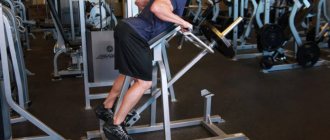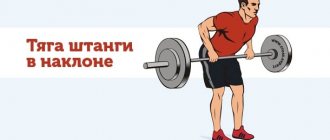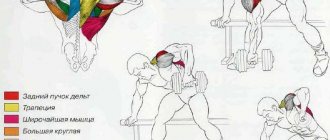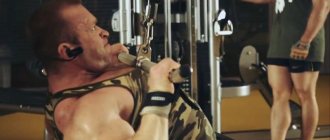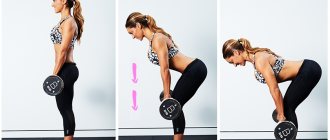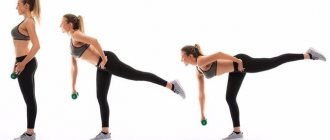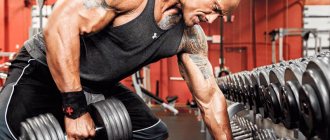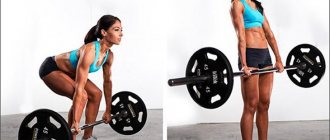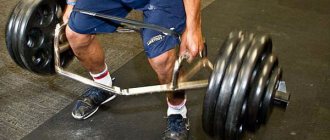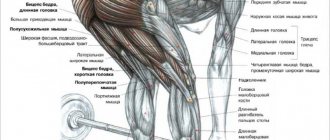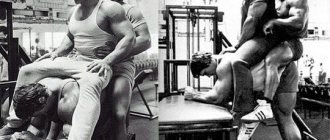Pros and cons of bent over rows
This is a complex exercise that involves several muscle groups. Thus, training using the exercise allows you not only to work out various muscle groups, but also to highly effectively train stabilizers and deep muscles, for example, spinal extensors and abdominal muscles.
The disadvantage of the exercise is considered to be a high risk of injury due to the lack of fixation of the spinal column. Lack of experience aggravates and increases the risk of serious injuries during the training process. This exercise requires adherence to technique and a gradual increase in working weight.
Bent-over barbell rows should not be performed with back and shoulder injuries.
Using Tools
Bent-over barbell raises can also be performed with a trap bar, curved bar, or additional weights.
Trap neck
The trap bar (hexagonal) allows you to perform the movement in the same way as with a regular bar, but at the same time grasp the apparatus with a neutral grip (palms facing each other). For many athletes, this position is more comfortable. In addition, the trap bar makes it easier for people who have problems with their wrists, elbows, or shoulders to train. It can also increase your range of motion if you have limited mobility in your shoulder blades.
“Bent-over barbell row with trap bar”
Curved neck
The curved bar allows for increased range of motion, which promotes greater hypertrophy. However, this does not always happen: for some athletes, on the contrary, it provides less amplitude compared to what they achieve with a straight bar.
“Bent-Over Barbell Row with a Curved Bar”
Weighting
Any bent-over barbell row can be performed with additional weights, but such approaches are typically practiced by more advanced athletes. When using chains and resistance bands, the higher you lift the weight, the stronger the resistance becomes. The photo below shows how expanders can be secured. You can simply throw the chains over the bar.
"Chain and expanders"
What muscles work when bent over?
- Latissimus dorsi muscles.
- Rhomboid muscles.
- Large round muscles.
- Posterior part of the deltoid muscles.
- Trapezius muscles.
- Back extensors.
- Biceps.
- Shoulder and brachioradialis muscles.
Choosing grip width
The traditional grip implies a right angle in the elbow joint when the barbell is pulled to the belt, but the grip can be changed to emphasize different muscles.
- The narrower the hands are on the bar , the more emphasis is placed on the work of the diamond-shaped ones;
- and with a wide grip, the teres major muscles, the back of the deltoid muscles, and also the trapezius muscles are involved in the work.
Tilt angle
The emphasis on some back muscles can be changed by tilting the torso.
- At a thirty-degree tilt, almost all back muscles are involved;
- and when the tilt changes to forty-five or fifty degrees , the muscles located in the upper back receive the load, namely: the trapezius muscles, the posterior deltoid muscles, as well as the teres minor and major muscles. Of course, the latissimus dorsi and rhomboid muscles are also involved during this exercise, but they work to a lesser extent.
The optimal tilt angle is considered to be close to thirty degrees.
Working muscles
Bent-over barbell lifts work the following muscle groups:
- Upper back . When lifting the weight, you should squeeze your shoulder blades together to bring the bar to your chest. This will work the latissimus dorsi (which is responsible for the V-shape of the torso), as well as the trapezius, rear deltoids, and all the small muscles of the upper back.
- Lower back . You already know how to do bent-over barbell rows correctly, so you must remember that your back always remains straight. When you lower the weight, you resist the load and strengthen the erector spinae muscle. It also protects the lower back from injury.
- Press . The abdominal muscles help keep the spine in a neutral position. That is, pulling the barbell to the waist while bent over allows you to pump up those same six-pack abs. If you eat right, they will become clearly visible very soon.
- The back of the thigh and buttocks . These muscle groups are activated when you lift the barbell from the floor. They also help keep your lower back straight.
- Hands . The forearm muscles help hold the barbell. The biceps are involved when bending your arms and lifting weights, and the triceps when moving your arms back (long head).
Technique for performing bent-over barbell rows with a straight grip
In order to perform the exercise correctly, the best option for a beginner athlete is to train with light weights.
- The athlete must stand in front of the barbell with his feet shoulder-width apart.
- Your knees should be slightly bent.
- You need to grab the barbell with your palms shoulder-width apart, without bending your elbows, then straighten up. The starting position is as follows: the lower back is slightly bent, the torso is tilted forward. The tilt angle is approximately 30 degrees.
- Legs are bent at the knees. The lower back muscles should be tense.
- The starting point of the barbell amplitude is at the athlete’s knees, the end point of the amplitude is at the waist.
- During the initial movement, inhale, and when pulling the barbell to the belt, exhale, after which, during the reverse return movement to the starting position, inhale again.
- Throughout the entire movement, the elbows should move exclusively back and up, they should not diverge to the sides. The athlete should try to raise his elbows as high as possible.
- Traction is carried out only by the back muscles.
- Remember that the lower back muscles should be tense throughout the entire approach.
- Avoid cheating and jerking. The movement must be performed concentrated and smoothly.
- When performing bent-over barbell rows, your legs and head should remain motionless.
Execution technique
Barbell row to the waist
- Typically, bodybuilders use racks in this exercise, put weight on them, take the barbell with a straight grip wider than the shoulders, straighten up, and remove it from the racks
- perform a forward bend due to flexion in the hip (mainly) and knee (optional) joint.
- Bending should be symmetrical on the right and left.
- Then, by adducting the shoulder blades and contracting the lats, the barbell is raised to the stomach and lowered smoothly.
Many people prefer to take the first repetition of this exercise from the floor using the deadlift technique. This makes sense as it helps to better engage the long back muscles and immediately place the shoulders in a neutral position. But other athletes believe that this way the athlete only loses strength in non-target movements. In practice, it is worth using both options and choosing the one that seems more convenient and accessible.
Important: this movement is technically difficult, especially for those who have never worked their back before. It’s better to take a smaller barbell and master contracting your lats on it than to hang a “serious weight” and lift it with your biceps and by cheating.
It's the BENT-UP ROW, baby!
Errors
The technical errors in this version of the movement apply to all bent over rows. People tend to push the weight too hard with non-target muscles and perform a lot of unnecessary movements that do not help pump up their back:
- Shallow slope . This leads to the fact that the lower muscles that run along the spine are overloaded, and a significant part of the weight falls on the lower back. If there is a curvature, and the athlete works with cheating, swinging his body, it turns out that he is constantly trying to displace the vertebrae in the lumbar region. This usually ends in pinched nerves and pain;
- Break and reach with the biceps . The athlete bends over, and everything seems to be in order, the barbell rises to the stomach or to the chest, but in reality, the athlete performs a kind of hybrid of biceps curls and “lifting” the back. It is clear that this way the load leaves the target muscle group and shifts to the arms. Usually all this also leads to a sprain of the elbow ligaments, since the athlete seems to “drop” the barbell from above;
- Rounded lumbar spine . Some trainers mistakenly believe that the main “evil” is the round chest. If an athlete has a curvature of the spine, it will remain slightly rounded, this is inevitable. But in fact, the more traumatic situation is when the “hump” in the lumbar region prevents you from performing the deadlift correctly. The reason for this may be either a simple lack of concentration on the training movement or insufficient flexibility of the hamstrings. The trend of recent years is to warm up the hamstrings on a foam roller. And they're not all that useless when it comes to eliminating "humps" in your deadlifts;
- Wrist flexion . Here the athlete performs additional work on the forearm, which only causes him discomfort and distracts him from the target pull. The wrists should be straight. If the grip in the exercises is the athlete’s weak point, he should use straps;
- Inadequate weight for physical fitness . A huge barbell only looks cool, but in reality a beginner will not be able to perform the movement with it technically. It is necessary to choose a weight at which tightening the shoulder blades to the spine and contracting the latissimus dorsi muscles is technically possible;
- Pressing your elbows to your body and stomach . So they will interfere with making a purely anatomical movement;
- Accelerating weight from the lower back . We are talking about a movement when the athlete straightens slightly and then, as it were, throws the bar down. This helps push the weight through inertial force to the middle of the amplitude. And above, the athlete perfectly reaches it with his biceps. It is clear that such exercises do not correspond to the purpose of the training, and jerks with the lower back should not be performed;
- Holding your breath . This is a typical beginner mistake. They usually do not breathe at all during strength exercises, occasionally taking ragged inhalations and exhalations. This leads to problems with both movement and recovery after training;
- Belt rows on the Smith machine . This talented interpretation of the movement does not allow the shoulders to work in their natural amplitude. As a result, a person can injure them. Although bodybuilding stars regularly show this particular option, and praise it as a version for “muscle variety and surprise”;
- Grip too narrow . It anatomically does not allow you to engage the latissimus muscles and load your back. With a too wide grip, the athlete pumps the rear deltoids, and with a narrow grip, the biceps
Reverse Grip Row
This movement increases the path of the bar, that is, makes the amplitude deeper. It contributes to greater back development, but only for those athletes who turn it on at the start. The technique differs only in that the barbell is taken with a reverse grip (like a biceps grip) slightly wider than shoulder-width apart. By tightening the back, the athlete begins to move and perform deadlifts.
Chest cravings
This variation is intended for more experienced athletes. It allows you to use both the lats and the “pillars”. It is distinguished by a deeper slope, the spine is parallel to the floor. The pull is carried out to the chest and through the back. It allows you to additionally load the trapezius and rear deltas. But this version of the exercise is contraindicated if there are lower back injuries, the athlete experiences discomfort in the thigh muscles when bending, or physically cannot reach the projectile to the chest due to weak opening of the shoulder joint.
bodymaster : Bent-over barbell row
Bent-over barbell row technique with a narrow reverse grip
This option is considered a more effective, but also more difficult exercise. An interesting fact is that it was invented by Dorian Yates himself! With a reverse grip, the load is placed on the lower latissimus dorsi muscles. Also, the muscles located in the center of the back are not excluded from the work.
When using a reverse grip, the amplitude increases. You can move your hands behind the body a little further. This technique allows you to reduce your back muscles as much as possible. The load on the lower biceps ligament also increases.
- In this case, your palms should be placed shoulder-width apart.
- The torso angle should be approximately 45 degrees.
- A bend in the lower back is necessary.
- The pelvis needs to be moved back a little. We start deadlifting from the level of the shins.
- Be sure to stretch the back muscles at the lowest point of the amplitude.
Recommendations
• To pump the upper part of the latissimus muscles, rhomboids, trapezius + posterior deltoids, pull the barbell just above the waist, to the area of the very bottom of the chest, and when lifting, move your elbows slightly to the sides, and not along the body.
• If the exercise fails, stand sideways to the mirror and perform the exercise with a virtual barbell, having clearly worked out the technique, then take an empty bar and try again, only after that hang weights on the barbell;
• If the exercise does not work, strengthen the muscles with hyperextension and pull-ups;
• Always touch your belt with the bar when lifting the bar; if you don’t reach the weight, it means it’s too heavy;
• When using heavy weights, use an athletic belt (relieves some of the load from the lower back) and gymnastic straps (will help hold the barbell until the end of the exercise).
• Look at one point from A to Z of the exercise, do not turn your head.
• If you do bent-over barbell rows with a reverse grip, try doing the exercise with an E-shaped bar, it’s even more convenient because it doesn’t break your forearms.
• When lifting the barbell up, do not straighten the angle of your back; it must be strictly fixed in one position from the beginning to the end of the exercise.
• Remember, the bar of the bar rises and falls strictly up and down, it should not move diagonally back and forth.
• Be sure to raise your arms so that your shoulder blades contract; this works the latissimus dorsi muscles especially well, while keeping your chest straight and your back straight.
Features and technique of bent-over abdominal rows in the Smith machine
The Smith deadlift is performed using a technique similar to the classic exercise. The benefits of working in a Smith machine are obvious. This is an opportunity to fix the load at any point of the amplitude, as well as reduce the load on the stabilizer muscles, since in the simulator the movements are fixed by guides, due to which there are no swings and inaccuracies in movement. This option also allows you to perform the exercise more technically.
An excellent option for training the back muscles for beginner athletes is working in a Smith machine. However, it cannot be said that technically this option for performing traction is simpler.
- To begin with, you should set the bar of the exercise machine at hip level.
- You need to stand in the center and clasp the bar with your palms shoulder-width apart, place your feet hip-width apart.
- Next, you need to remove the bar from the clamps and tilt your body forward at 45 degrees and bend your knees.
- Your arms should be straight at the bottom of the movement.
- As you exhale, you need to stretch the bar to your waist, keeping your elbows close to your body. At the top of the movement, it is important to bring the shoulder blades to the center, contracting the back muscles.
- As you inhale, it is important to smoothly lower the bar to the lowest point, approximately to the middle of the shin. The main thing is not to throw the barbell down and not to swing your body.
- While performing the exercise, the knees and torso remain motionless.
When to expect an effect
The effect of performing bent-over rows appears within 2-3 sessions. A girl or woman who includes this exercise in her training split will find it easier to endure walking, her posture will improve, and it will be easier to keep her back in the correct position.
Bent-over barbell rows are an integral part of the training process for girls who aim to develop a beautiful figure and maintain health.
This basic athletic movement promotes the harmonious development of muscles throughout the body and strengthens almost the entire chain of postural muscles. Their functional readiness is the key to beautiful posture and athletic longevity.
Recommendations for performing standing bent-over rows with a barbell for men and women
This exercise is complex and energy-consuming, therefore, depending on the athlete’s level of training, it should be done first or second in the training process. Here is an example of a back workout using this exercise for a beginner athlete:
- Reverse grip pull-ups: 2-4x8-12.
- Wide grip bent over row: 2-4x8-12.
- Horizontal block thrust: 2-4x8-12.
- Hyperextension: 2-4x15-20.
Women can perform this exercise on a Smith machine. Rows can be combined with hyperextensions or reverse pull-ups in a superset. The optimal number of repetitions will be in the range from 20 to 25. You can limit yourself to two or three approaches.
To shift the load to the upper back, pull the barbell towards the chest area and spread your elbows to the sides. This version of the exercise is considered more difficult than the classic one.
Exercise options
Depending on which segment of the lats you want to focus on, bent over rows can be performed in different ways. Among the most effective and common are the following:
- straight grip barbell row;
- reverse grip barbell row;
- explosive bent-over barbell row;
- barbell row in the Smith machine;
- barbell row lying on your stomach on a bench;
- pulling the barbell to the chest.
Rows with forward and reverse grip
Bent-over barbell rows with a straight grip load the entire array of latissimus muscles and are the main tool for building a wide and sculpted back.
Bent-over barbell rows with a reverse grip place more load on the lower segment of the latissimus dorsi muscles, due to which the back muscles become more prominent and proportional. It is this variation of the bent-over row that creates that very V-shaped silhouette that the vast majority of gym goers are chasing.
Explosive bent over row
Explosive Bent Over Row – The motion vector is about the same as a regular Bent Over Row, but after each repetition we must place the barbell back on the floor and pause for one to two seconds. You can work with any grip convenient for you. This exercise perfectly develops the explosive power of all the muscles of your torso and increases your grip strength. It should be performed with moderate weight, without using an athletic belt or straps.
Smith machine row
Bent-over barbell rows on a Smith machine allow you to better focus on peak contraction of your back muscles. Due to a short pause and “squeezing” the working muscles in the upper position, the back visually becomes more lumpy and developed.
Barbell row lying on a bench
The barbell row lying on a bench is a more isolated exercise for the back muscles, representing a kind of T-bar row with emphasis on the stomach. Can be performed on both a horizontal and an inclined bench. In this exercise, there is virtually no axial load on the spine, so it can be performed by athletes who have medical contraindications to performing bent-over barbell or dumbbell rows.
Bent over row
The bent-over row of the barbell shifts most of the load to the rear deltoid muscles and the back of the trapezius, while the latissimus dorsi muscles act as a kind of assistant in the movement. It is recommended to perform this exercise with a light working weight and try to concentrate as much as possible on contracting the muscles we need. Remember that the middle and rear delts like maximum isolation work, light weights and high repetitions.
